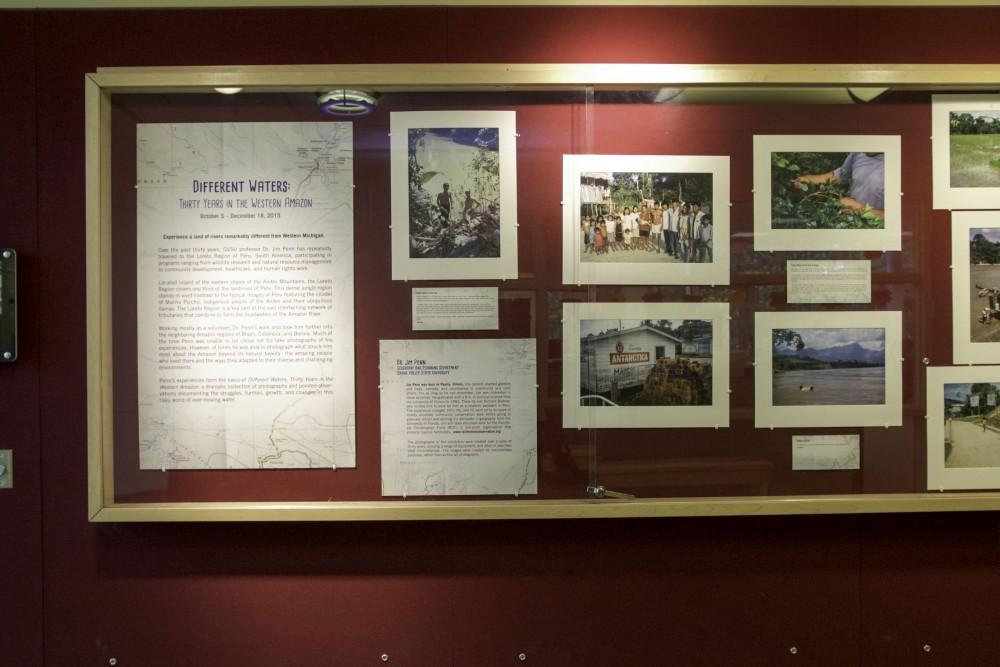Red Wall Gallery displays stories of the Amazon

GVL / Sara Carte The exhibit “Different Waters” is featured on the red wall gallery on the first floor of Lake Ontario on Oct.15.
Oct 19, 2015
Though the threat of snow may loom closely on the horizon for Grand Valley State University, a new exhibit in Lake Ontario Hall’s Red Wall Gallery hopes to open students’ eyes to a world where the presence of water is often a much more dangerous inconvenience.
“Different Waters: 30 Years in the Western Amazon,” documents the many travels of GVSU professor Jim Penn to Peru and nearby areas of South America. Engaging in projects ranging from zoological research to human rights work, Penn took photos of his journeys over the course of three decades.
Of the 400 photos Penn submitted to the gallery, the exhibit features 72 that depict not only the trouble and turmoil faced by the people living alongside the Amazon River, but also how their ingenuity has allowed them to adapt to it and grow, said Penn.
David Newell, GVSU’s curator of exhibitions, said he decided which pieces to include in the exhibition based on the story he wanted the exhibit to tell.
“There’s stories within this that I think are very telling. They may be subtle, but I hope they resonate with people. It really is opening people’s eyes to another world,” he said. “They aren’t glamorous photos by any means. Sometimes they’re out of focus; sometimes they’re grainy or there’s staining. It just sort of represents the environment these things were happening in…it’s not a comfortable world, but there’s an entire culture existing there.”
Penn also spoke about the importance of storytelling through photographs.
“It felt good that I was able to tell some real stories about what’s going on,” he said. “A lot of people think (the Amazon is) some nice green forest and everybody lives this happy-go-lucky life, when really there’s all kinds of social issues that challenge people: there’s poverty, a lack of education, a lot of corruption and a lot of abuse of the people.”
This political corruption can be seen in a group of photos noted by both Newell and Penn that features a man holding a large fish.
“This is the president of the nation,” said Newell. “He was having a photo op, and they staged the whole thing. He was flying into a fish farm that was a scam, and they weren’t doing anything. They found out he was coming, they went out and bought the fish, stocked the fish ponds…made him think everything was wonderful, (and) he got his photo op. It makes you wonder about the reality of politics.”
But despite the struggles seen in the photos, Penn said he has also seen growth in his travels.
“I still think there are a lot of glimmers of hope. Just the fact that young people (living in the Amazon) are trying to educate themselves and are working really hard,” he said. “They’ll do sorts of creative and imaginary things to make a living. Whether it’s the guy selling gasoline out of bottles or people with a floating mechanic site. People want to work and they want to work really hard and have their children have a better life. I think that the situation in these villages have gotten better because we’ve helped the people to empower themselves.”
Newell said he noticed hope and happiness in the photographs.
“This strikes me as a very inconvenient world. Pleasures are few and far between, (and) you find your joy where you can,” said Newell. “But the kids are always smiling. The people look happy. So there must be something fulfilling there.”
The exhibit will remain on display through Dec. 18, and a formal reception will be held for the exhibit in November.
For students interested in combating the destruction of the Amazon rainforest and helping the people who live therein, Penn said he encourages them to contact him to work on the formation of a student group. He said interested students could take GPY 361 to learn more in the winter semester or GPY 425, a study abroad field course in Peru. For more information, Penn can be reached at [email protected].























